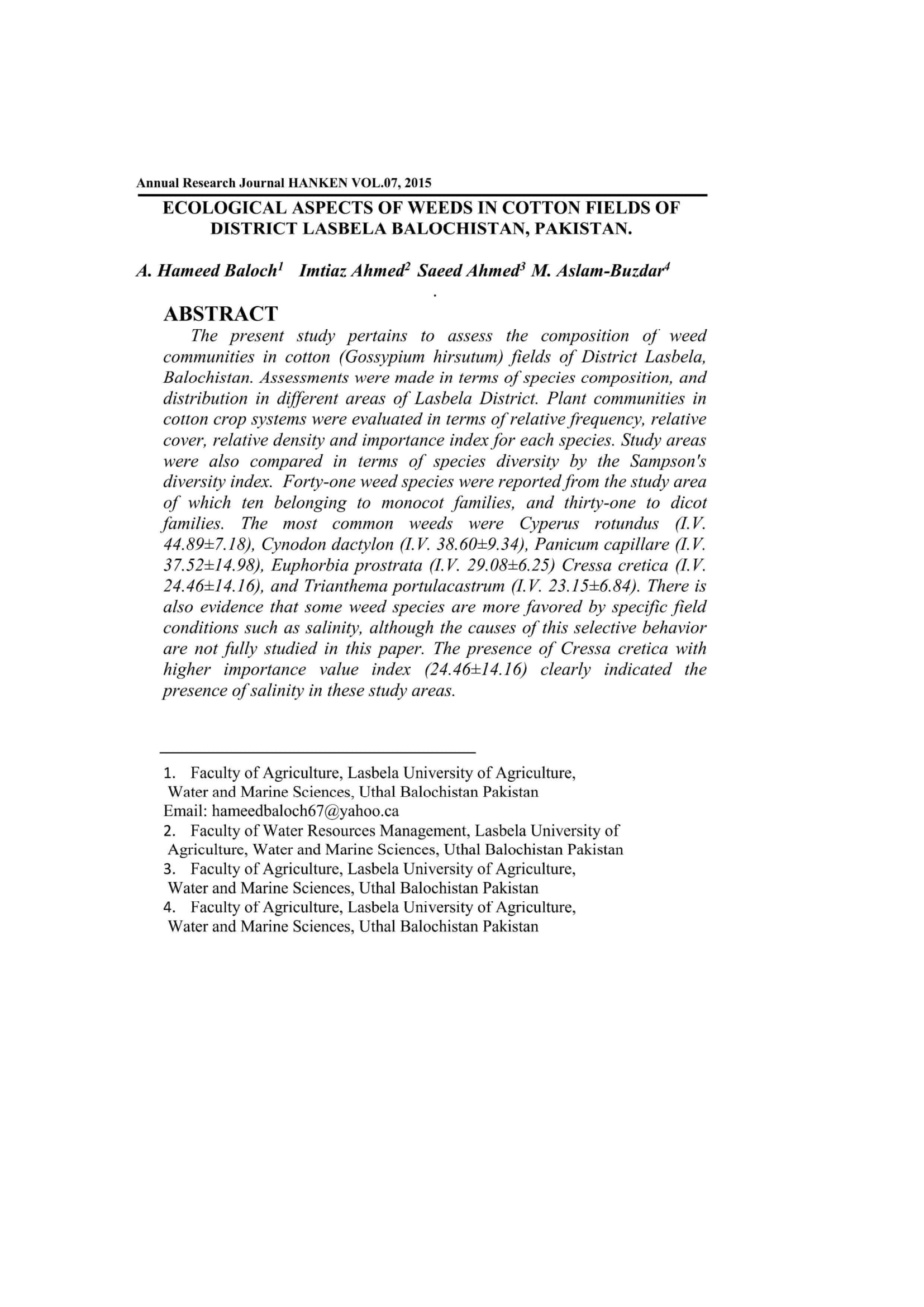ECOLOGICAL ASPECTS OF WEEDS IN COTTON FIELDS OF DISTRICT LASBELA BALOCHISTAN, PAKISTAN.
Keywords:
Lasbela, Weed, Cotton, Cyperus rotundus, Panicum capillare, Cressa cretica.Abstract
The present study pertains to assess the composition of weed communities in cotton (Gossypium hirsutum) fields of District Lasbela, Balochistan. Assessments were made in terms of species composition, and distribution in different areas of Lasbela District. Plant communities in cotton crop systems were evaluated in terms of relative frequency, relative cover, relative density and importance index for each species. Study areas were also compared in terms of species diversity by the Sampson's diversity index. Forty-one weed species were reported from the study area of which ten belonging to monocot families, and thirty-one to dicot families. The most common weeds were Cyperus rotundus (I.V. 44.89±7.18), Cynodon dactylon (I.V. 38.60±9.34), Panicum capillare (I.V. 37.52±14.98), Euphorbia prostrata (I.V. 29.08±6.25) Cressa cretica (I.V. 24.46±14.16), and Trianthema portulacastrum (I.V. 23.15±6.84). There is also evidence that some weed species are more favored by specific field conditions such as salinity, although the causes of this selective behavior are not fully studied in this paper. The presence of Cressa cretica with higher importance value index (24.46±14.16) clearly indicated the presence of salinity in these study areas.
References
Anonymous. 2012. Agricultural Statistics Balochistan. Directorate of Crop Reporting Services, Agricultural Department Balochistan Quetta. p.26.
Aziz, S. 1994. Population biology of desert perennial halophyte Cressa cretica. M. Phil. thesis, Department of Botany, University of Karachi, Pakistan.
Berg, W. A.1995. Response of a mixed native warm-season grass planting to nitrogen fertilization. J. Range Manage. 48: 64–67.
Bhatti, N.M., A.Q. Mahar, A.R. Malik, G.S. Markhand and N. Ismaili. 1993. Weed Flora of Cotton (Gossypium hirsutum L.) fields in District Khairpur. Scientific Sindh, Ann. Jour. of Res., 1: 127-129.
Brohi, R. and M.U. Makhdoom. 1987. Weed Control in Cotton in Sind. Advances in Weed Science, a case of Indo-Pakistan subcontinent. Proceedings of the Pak-Indo-US Weed Control Workshop, NARC., Islamabad, Pakistan. 419-428.
Clements, D. R., DiTommaso, A., Darbyshire, S. J., Cavers, P. B. and Sartonov, A. D. 2004. The biology of Canadian weeds. 127. Panicum capillare L. Can. J. Plant Sci. 84: 327–341.
Curtis JT, Mclntosh RP. 1950. The interrelationships of certain analytic and synthetic Phytosocioogical characters. Ecology 31, 434-455.
Darbyshire, S. J. and Cayouette, J. 1995. Identification of the species in the Panicum capillare complex (Poaceae) from eastern Canada and adjacent New York State. Can. J. Bot. 73: 333–348.
Dore, W. and McNeill, J. 1980. Grasses of Ontario. Biosystematics Research Institute, Ottawa, ON. 566 pp.
Drake, J. A., Mooney, H. A., Castri, F. d., Groves, R. H., Kruger, F. J., Aejmamek, M., & Williamson, M., 1989. Biological Invasions: a global perspective. Chichester: John Wiley & Sons.
Flora of Pakistan online access http://www.efloras.org/flora_page.aspx?flora_id=5: accessed June- July 2013.
Hawes, C., Squire, G. R., Hallett, P. D., Watson, C. A., & Young, M. 2010. Arable plant communities as indicators of farming practice. Agriculture Ecosystems & Environment, 138(1-2), 17-26.
Hussain, F. and T.W. Khan. 1987. Allelopathic effects of Pakistani weeds. Cynodon dactylon (L.) Pers. Pak. J. Weed Sci. Res. 1. pp.120-124.
Hussain, M., S.A. Saeed, A. Rao, A. R. Bajwa and M. Yaqub. 1987. Weed Spectrum and Competition in Cotton (Gossypium hirsutum L.). Advances in Weed Science, a case of Indo-Pakistan subcontinent. Proceedings of the Pak-Indo-US Weed Control Workshop, NARC.Islamabad, Pakistan, 437-443.
Khan, M. A. 1991. Studies on seed germination of Cressa cretica. Pakistan Journal of Weed Science Research 4: 89-98.
Malik M.A. Khan .Z. and Khan. A., 2012: Weed Diversity In Wheat Fields Of Upper Indus Plains In Punjab, Pakistan. Pak. J. Weed Sci. Res. 18(3): 413-414. Mayor, J. P., & Dessaint, F. (1998). Influence of weed management strategies on soil seedbank diversity. Weed Research, 38(2), 95-105.
McCloskey, W.B., P.B. Baker, and W. Sherman. 1998. Survey of Cotton Weeds and Weed Control Practices in Arizona Upland Cotton Fields. Cotton, A College of Agriculture Report,Series P112:241-254. http://ag.arizona.edu/pubs/crops/az1006/az10066a.html.
Memon, R.A.2000. Weeds a threat to wheat crop in Agriculture and Technology. Dawn, Economic and Business Review, April 18, 2000.
Memon, R.A. and Bhatti, G.R. 2001. Weeds of Cotton Crop in District Khairpur. Pak. J.Bot., 33: 753-759.
Memon, R.A., Bhatti, G.R., Khalid, S., Soomro R. and Ahmed S., 2007:A Survey Of Weeds Found In Cotton Fields Of The Khairpur District, Sindh, Pakistan: Pak. J. Bot., 39(7): 2265-2274.
Menalled, F. D., Gross, K. L., & Hammond, M. (2001). Weed aboveground and seedbank community responses to agricultural management systems. Ecological Applications, 11(6), 1586-1601.


